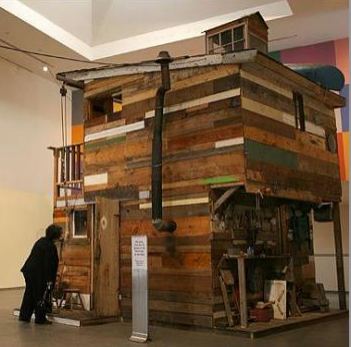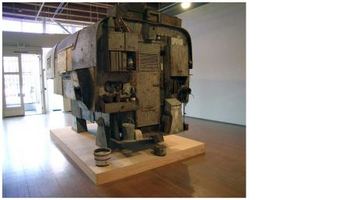I haven’t seen Ethan Hayes-Chute‘s Hermitage, which the Boston Globe describes as a “life-size re-creation of a hermit’s two-story wooden cabin, made with materials salvaged from dumpsters, construction sites,” but boy howdy have I seen it.
 Whiting Tennis offered something similar a couple of years ago titled Bovine.
Whiting Tennis offered something similar a couple of years ago titled Bovine.
 Some hard-scrabble hermit might have built either one from scraps and lived in it for decades, picking his nose and peeing out the door. Good luck to the guy. (I might be joining him shortly.) As art, however, both sculptures reek of frontier nostalgia and trade in wild West stereotypes. They’re shabby chic without the chic.
Some hard-scrabble hermit might have built either one from scraps and lived in it for decades, picking his nose and peeing out the door. Good luck to the guy. (I might be joining him shortly.) As art, however, both sculptures reek of frontier nostalgia and trade in wild West stereotypes. They’re shabby chic without the chic.
The big daddy of this sensibility is Ed Kienholtz. Hayes-Chute’s and Tennis’ sculptures are mites, and Kienholtz’s are mountains.
Everybody recycles, especially now, when the idea of breaking new ground has itself broken down. Evoking the past is not the problem. It’s evoking it in a half-assed, me-too manner, hoping to hitch a dull wagon to somebody else’s bright star.
In an exhibit titled Second Peoples at the lamentably demised Tacoma gallery known as The Helm, the killer-good artist statement on the subject reads as follows:
We
have coined the name ‘second peoples’ to describe the people who arrive
late on the scene, after the beginning, after the abundance, after the
traumatic event, after everything’s been said and done, after, even,
the end.We are the second peoples. Chances are, you are too.
This is an exhibition dealing with what it means to be second. We
inhabit a landscape of iteration, reverb, elision, and generational
noise. Our corner of North America – these mountains, that timber, this
rich land – belonged to someone else. Our popular culture-those TV
shows, that movie sequel, this new band that is so retro they’re
cool-belonged to some other time. Our art is that way, too: this
gesture to Donald Judd, that nod to Philip Guston, that Eva Hesse wink.We are interested in locating the coordinates of this second
position. How did we end up here? What is our responsibility for what
happened before us? What is our responsibility for the things that
happen now in our names? Like Simone de Beauvoir argues in “Second
Sex”, we think we should be free to transcend ourselves as subjects, to
not be confined to existential leftovers.
Contemporary art is concerned with this alchemy, trying to
turn second-handedness into first-handedness, reversing the flow of
energy, presenting not representing, creating value from valuelessness.
We think this is a worthwhile activity. We also think it is a fraught
activity. The work in this exhibition exposes some of the fractures
created by this ceaseless turning, and also dreams of a third position,
a reification of our desire to escape, a momentary place to stop.
For a brilliant, 21st-century version of the Kienholtz aesthetic, go here for a look at a Seattle Art Museum project by the brothers Oscar Tuazon and Eli Hansen. (It’s another Michael Darling effort. He is who is in Seattle curatorial circles. In his field, nobody else comes near.)



The beauty of the Pacific Northwest art scene was for a long time the abundance of cheap large studio space and the no dominant style attitude of the art scene. The Seattle and Portland scene was filled with artists working out their ideas without the pressure to conform. Influences form other places, sure. But if one wanted to paint abstract long after that train has left the station, Seattle was your town. With the advent of the municipal arts funding and acquisitions the need to look like other places in our collective art collection became paramount. Local art was jettisoned, imitative art was made the new kid on the block and the emerging art school “artists” only reinforced the idea that art from some where else was better than the local art. That’s pretty much the story today too. However in my experience and travels, art from the PNW is on par with art from any other part of the globe. Art criticism, publication and local art history, that’s what has been lacking for the entire history of art of the Pacific Northwest. Those who can and could make a difference seem more interested in polishing their own apple in the big apple or LA…in a sense they are the real “seconds” and are cleverly trying to push that mentality off on the artists that they review. But really it’s the critics who are the seconds for they are the ones who are afraid to follow any trend except the current one.